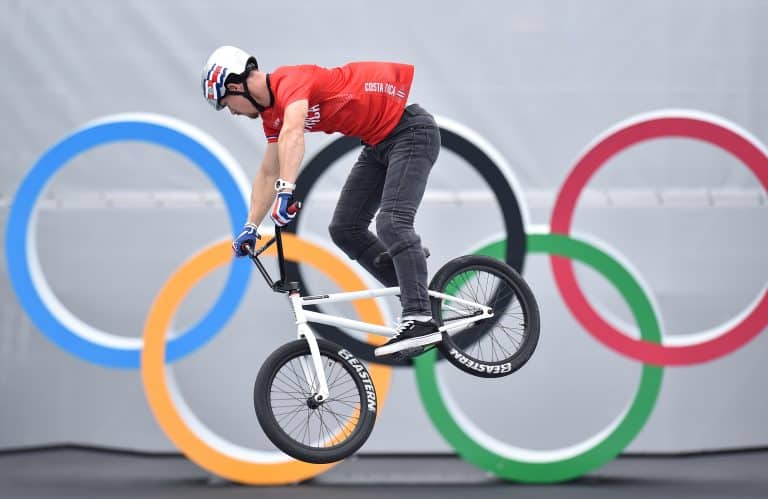- New research has analysed Olympic injury data since 2008 to identify which Olympic sports are the riskiest for beginners.
- BMX emerged as the most dangerous Olympic sport, with a 34.38% injury rate, while Canoe Slalom was the safest, with a 1.2% rate.
- The London 2012 Olympics had the highest overall injury rate, with 12.8% of athletes reporting injuries.
New statistical analysis has identified the most injury-prone Olympic sports, with over one-third of BMX cyclists suffering injuries during competition.
While Olympic sports like BMX may carry a high injury risk for athletes, those looking for a safer way to enjoy the thrill of competition can turn to platforms like 1xbet casino. Offering a wide range of games, this platform provides an exciting yet risk-free alternative for those who prefer to avoid the physical dangers of traditional sports while still enjoying the excitement of winning.
Olympic Sports Most Prone to Injury
BMX racing proved the most dangerous Olympic sport, with 34.38% of athletes sustaining injuries. The risk was exceptionally high in 2016, with 37.5% of BMX riders injured, compared to 31.3% in 2012. While 2020 (held in 2021 due to the COVID-19 pandemic) saw a significant decline to 26% for BMX racing, BMX freestyle still posed a risk, with over 6% of athletes injured.
Olympic Sports with the Highest Injury Rate
| Rank | Sport Name | Average Rate of Olympic Injury |
| 1 | Cycling – BMX | 34.38% |
| 2 | Taekwondo | 29.92% |
| 3 | Football | 27.19% |
| 4 | Cycling – MTB | 22.44% |
| 5 | Boxing | 18.12% |
| 6 | Handball | 17.98% |
| 7 | Hockey | 16.55% |
| 8 | Weightlifting | 15.86% |
| 9 | Water polo | 14.03% |
| 10 | Athletics | 13.04% |
Taekwondo follows closely behind BMX as the second most dangerous Olympic sport, with nearly 30% of athletes suffering injuries. While the risk was halved in Tokyo 2020, it peaked at a concerning 39% in 2012. Football also carries a high risk, with over 27% of its 1,508 competitors between 2008 and 2016 experiencing injuries.
Mountain biking (MTB), while averaging a risk of 22.44%, saw a dramatic decrease in injuries in 2020 to just 7%. Most injuries were minor, with about 1% lasting longer than a week. Despite a lower average injury rate of 18.12%, boxing had the second-highest number of injured athletes at the last Olympics, indicating a growing risk. Despite a lower overall injury rate of 18.12%, 5% of boxing injuries in 2020 lasted over a week. It had the second-highest number of injured athletes at the last Olympics, suggesting a growing danger.
Olympic Sports Least Prone to Injury
Canoe slalom boasts the safest record of all Olympic sports, with an average injury rate of just 1.2% over the past four Games. The last Olympics saw an impressively low injury rate of under 5%, with only two reported injuries between 2012 and 2016.
Olympic Sports with the Lowest Injury Rate
| Rank | Sport Name | Average Rate of Olympic Injury |
| 1 | Canoe slalom | 1.20% |
| 2 | Canoeing/kayaking (all types) | 2.23% |
| 3 | Shooting | 2.24% |
| 4 | Rowing | 2.25% |
| 5 | Canoe sprint | 3.22% |
| 6 | Archery | 3.65% |
| 7 | Swimming | 3.78% |
| 8 | Cycling – Track | 4.24% |
| 9 | Gymnastics – Trampoline | 4.69% |
| 10 | Equestrian | 4.73% |
All types of kayaking and canoeing are considered safe Olympic sports, with an average injury rate of 2.23%. Despite 987 competitors between 2008 and 2016, only 22 injuries were recorded. Shooting is also relatively safe, with a similar injury rate of 2.24% and 26 injuries across three Olympic Games.
Rowing follows closely behind, averaging a 2.25% injury rate out of 1,640 Olympians, with only 3% of athletes injured in 2020. Canoe sprint, while still relatively safe, has a slightly higher injury rate of 3.22%, with 3% of athletes injured in 2020 and 1% experiencing injuries lasting over a week.
Commenting on the findings, Alex Gambler, a spokesperson for Casinority, said: “Trying new sports can be exhilarating, but it’s essential to approach it with caution. The high injury rates among professionals highlight the significant risks involved, especially for beginners.”
“While physical activity is crucial for overall well-being, choosing sports that suit your fitness level and skillset is equally important. Starting with less demanding activities and gradually increasing intensity is a safer approach. Remember, the goal is to enjoy exercise, not to replicate Olympic feats. By listening to your body and seeking professional guidance, you can reap the benefits of an active lifestyle without putting yourself at undue risk.”
For more information, visit https://casinority.com/

